stop start HONDA CIVIC 2003 7.G User Guide
[x] Cancel search | Manufacturer: HONDA, Model Year: 2003, Model line: CIVIC, Model: HONDA CIVIC 2003 7.GPages: 1139, PDF Size: 28.19 MB
Page 531 of 1139
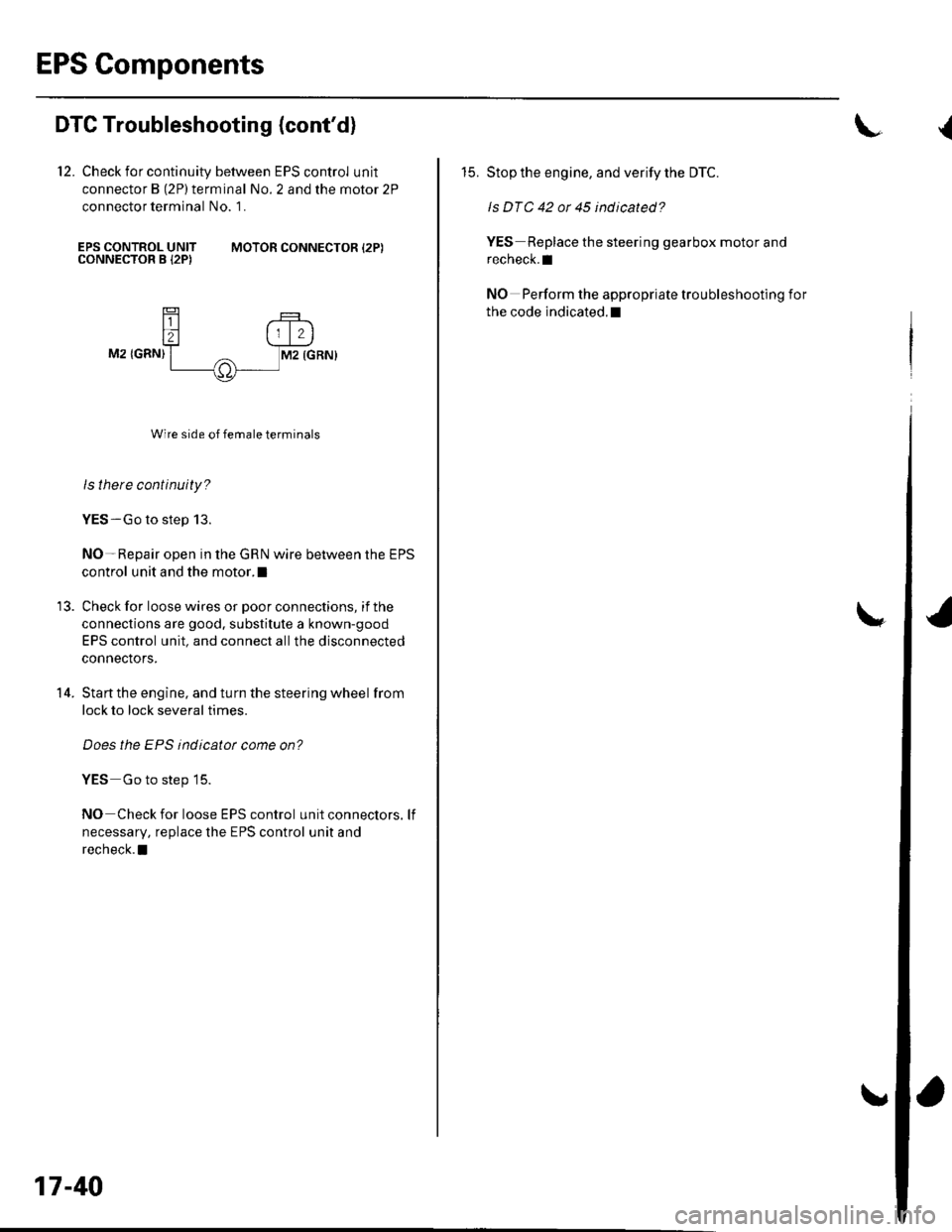
EPS Gomponents
DTG Troubleshooting (cont'd)
12. Check for continuity between EPS control unit
connector B (2P)terminal No. 2 and the motor 2P
connector terminal No. 1.
EPS CONTROL UNITCONNECTOR B I2PIMOTOR CONNECTOR {2P)
14.
M2 IGRN)
Wire side of female terminals
ls there continuity?
YES-Go to step 13.
NO-Repair open in the GRN wire between the EPS
control unit and the motor.l
Check for loose wires or poor connections, if the
connections are good. substitute a known-good
EPS control unit, and connect allthe disconnected
connectors.
Start the engine, and turn the steering wheel from
lock to lock several times.
Does the EPS indicatot come on?
YES Go to step 15.
NO Check for loose EPS control unitconnectors. lf
necessary, replace the EPS control unit and
recheck. a
17-40
L
15. Stop the engine, and verify the DTC.
ls DTC 42 or 45 indicated?
YES Replace the steering gearbox motor and
recheck.l
NO Perform the appropriate troubleshooting for
the code indicated.l
(
Page 532 of 1139
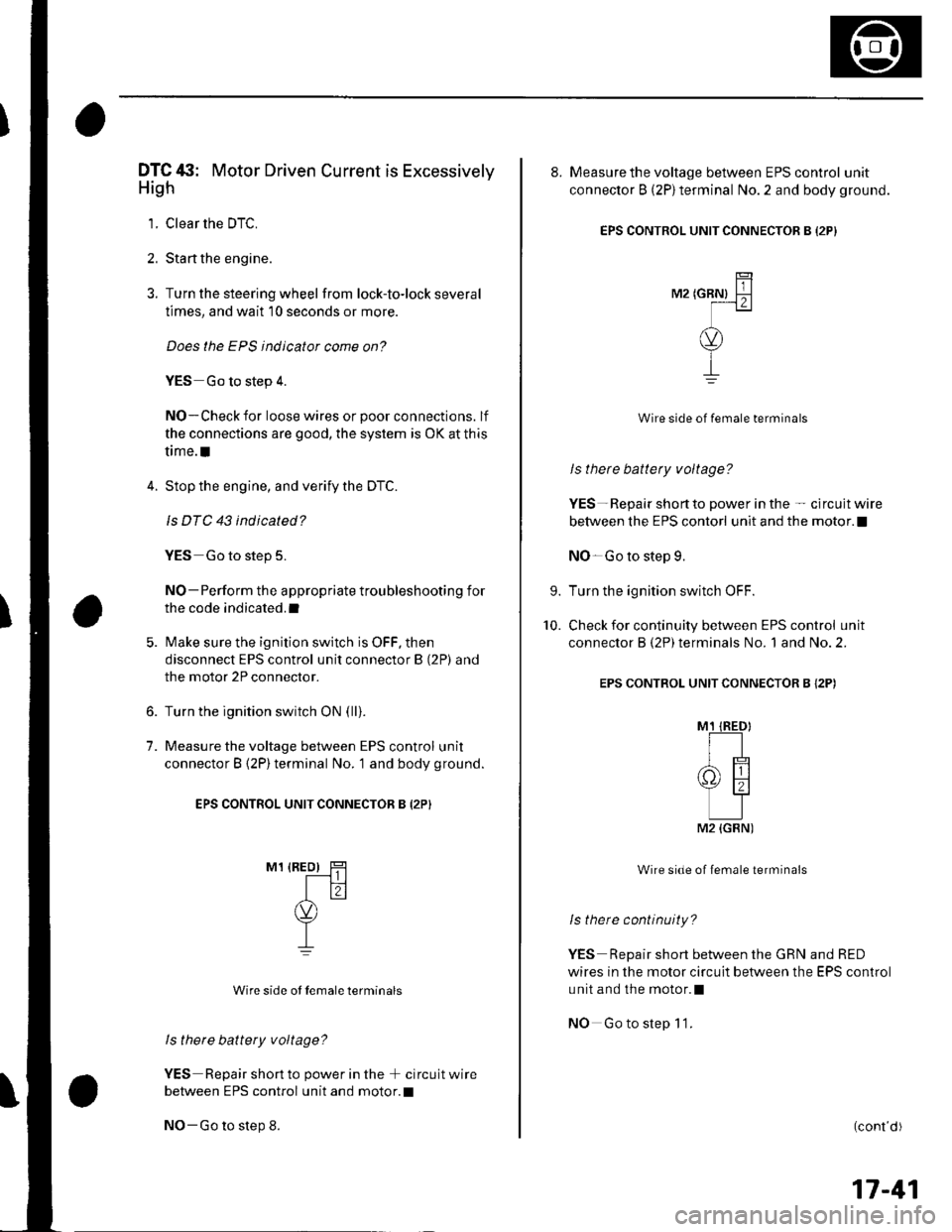
DTC tli|: Motor Driven Current is Excessively
Hish
1. Clear the DTC.
2. Start the engine.
3. Turn the steering wheel from lock-to-lock several
times, and wait '10 seconds or more.
Does the EPS indicator come on?
YES Go to step 4.
NO-Check for loose wires or poor connections. lf
the connections are good, the system is OK at this
ttme.I
4. Stop the engine, and verify the DTC.
ls DTC 43 indicated?
YES Go to step 5.
NO-Perform the appropriate troubleshooting for
the code indicated.I
5. Make sure the ignition switch is OFF, then
disconnect EPS control unit connector B (2P) and
the motor 2P connector.
6. Turn the ignition switch ON (ll).
7. Measure the voltage between EPS control unit
connector B (2P)terminal No. '1 and body ground.
EPS CONTROL UNIT CONNECTOR B {2P}
M1 {REo) HT------t I I
Itr(v)
T-L
Wire side ot Iemale terminals
ls therc battery voltage?
YES Repair short to power in the + circuit wire
between EPS control unit and motor.l
NO-Go to step 8.
8. Measure the voltage between EPS control unit
connector B (2P)terminal No. 2 and body ground.
EPS CONTROL UNIT CONNECTOR B I2PI
TilM2 tcRNl F-lf---1 z I
(v)
Y
I
Wire side of female terminals
ls there battety voltage?
YES- Repair short to power in the - circuit wire
between the EPS contorl unit and the motor. !
NO-Go to step 9.
Turn the ignition switch OFF.
Check for continuity between EPS control unit
connector B (2P) terminals No. 1 and No. 2.
EPS CONTROL UNIT CONNECTOR B {2P)
Wire side of female terminals
ls there continuity?
YES Repair short between the GRN and RED
wires in the motor circuit between the EPS control
unit and the motor.l
NO Gotostep 11.
9.
10.
(cont d)
17-41
M2 {GBN)
Page 533 of 1139
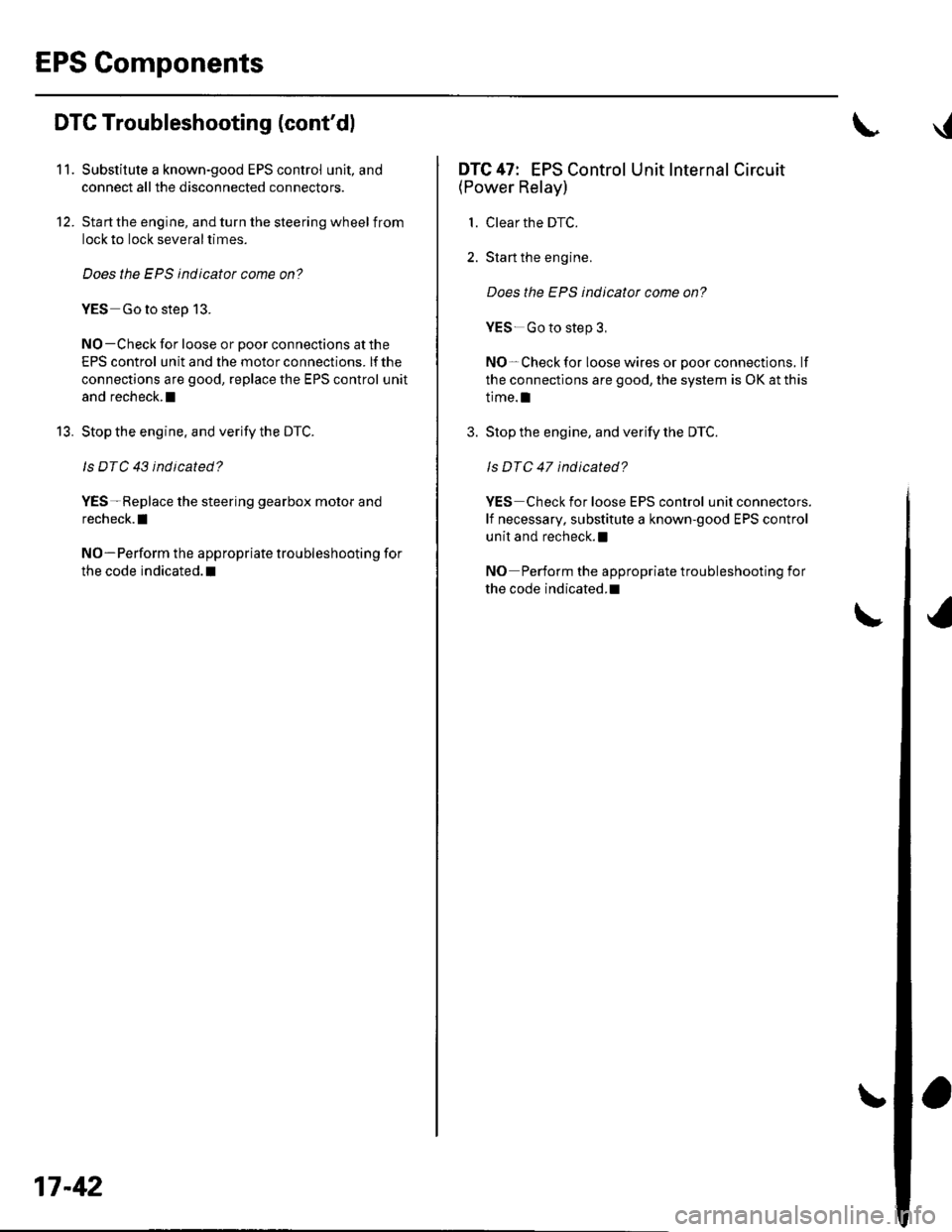
EPS Components
11.
12.
DTC Troubleshooting (cont'dl
Substitute a known-good EPS control unit, and
connect all the disconnected connectors.
Sta rt the engine, and turn the steering wheel from
lock to lock several times.
Does the EPS indicator come on?
YES Go to step 13.
NO -Check for loose or poor connections at the
EPS control unit and the motor connections. lf the
connections are good, replace the EPS control unit
and recheck.l
Stop the engine, and verity the DTC.
ls DTC 43 indicated?
YES-Replace the steering gearbox motor and
recheck. tl
NO-Perform the appropriate troubleshooting for
the code indicated.l
13.
17-42
DTC 47: EPS Control Unit lnternal Circuit(Power Relay)
1. Clear the DTC.
2. Start the engine.
Does the EPS indicator come on?
YES-Go to step 3,
NO-Check for loose wires or poor connections, lf
the connections are good, the system is OK at this
time.I
3. Stop the engine, and verify the DTC.
ls DTC 47 indicated?
YES Check for loose EPS control unit connectors.
lf necessary, substitute a known-good EPS control
unit and recheck.l
NO Perform the appropriate troubleshooting for
the code indicated.I
(
Page 534 of 1139
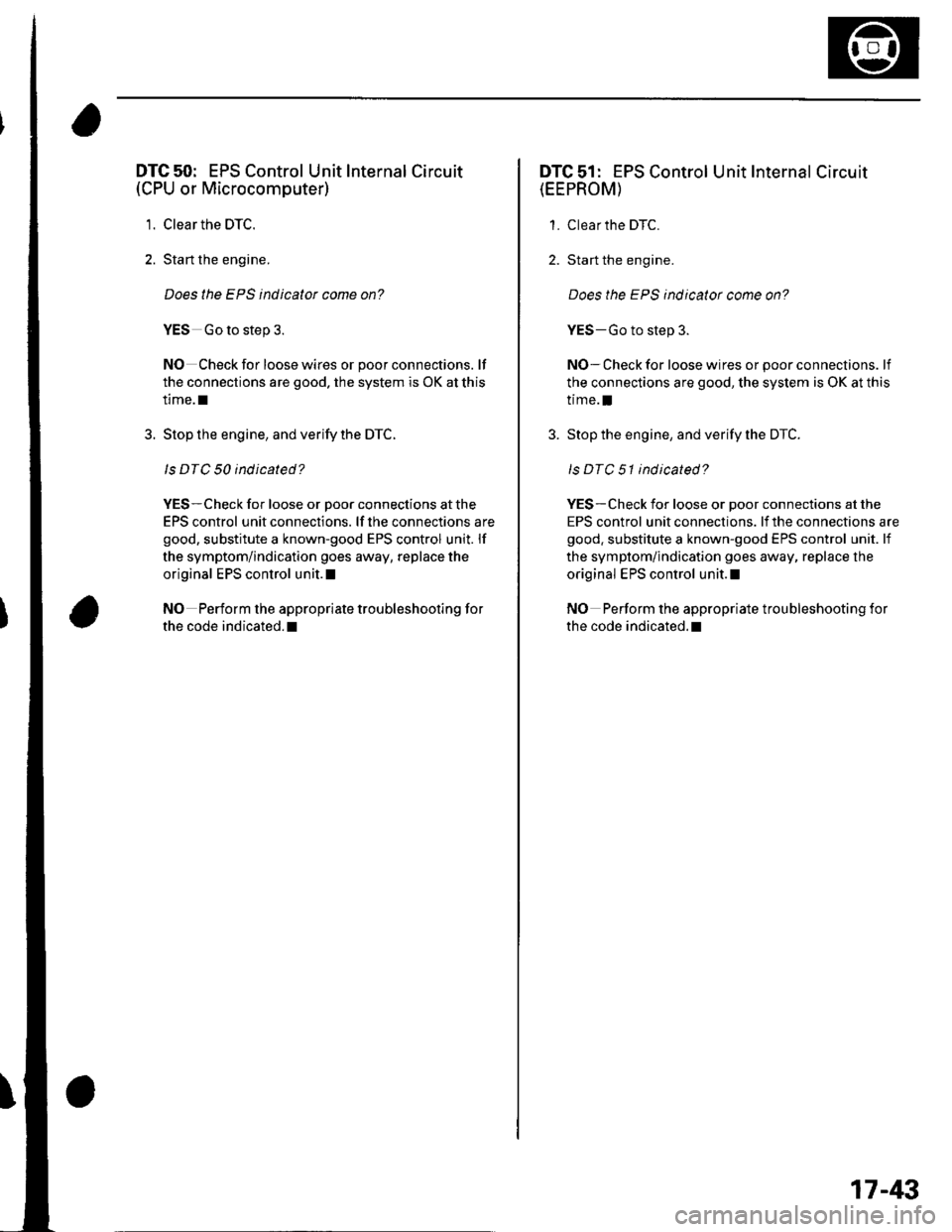
DTC 50: EPS Control Unit Internal Circuit(CPU or Microcomputer)
1. Clear the DTC.
2. Sta rt the engine.
Does the EPS indicator come on?
YES Go to step 3.
NO Check for loose wires or poor connections. lf
the connections are good. the system is OK at this
time. t
3. Stop the engine, and verify the DTC.
ls DTC 50 indicated?
YES-Check for loose or poor connections at the
EPS control unit connections. lf the connections are
good, substitute a known-good EPS control unit. lf
the symptom/indication goes away, replace the
original EPS control unit.l
NO Perform the appropriate troubleshooting for
the code indicated. t
DTC 51: EPS Control Unit Internal Circuit(EEPROM)
1. Clear the DTC.
2. Start the engine.
Does the EPS indicatot come on?
YES-Go to step 3.
NO-Check for loose wires or poor connections. lf
the connections are good, the system is OK at this
time.I
3. Stop the engine, and verify the DTC.
ls DTC 51 indicated?
YES-Check for loose or poor connections at the
EPS control unit connections. lf the connections are
good. substitute a known-good EPS control unit. lf
the symptom/indication goes away, replace the
original EPS control unit. !
NO Perform the appropriate troubleshooting for
the code indicated. t
17-43
Page 535 of 1139
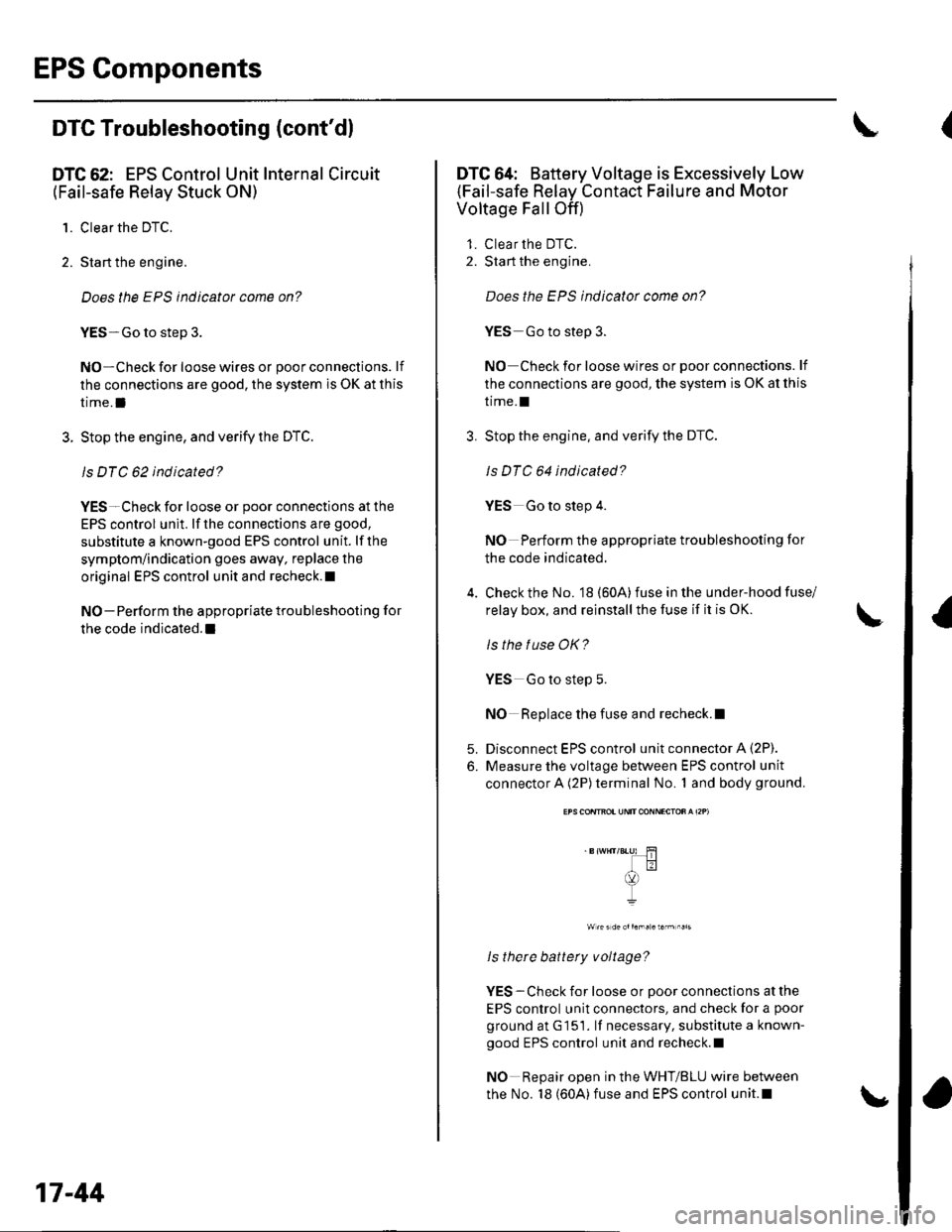
EPS Components
DTC Troubleshootang (cont'dl
DTC 62: EPS Control Unit Internal Circuit
(Fail-safe Relay Stuck ON)
'1. Clear the DTC.
2. Start the engine.
Does the EPS indicator come on?
YES-Go to step 3.
NO-Check for loose wires or poor connections. lf
the connections are good, the system is OK at this
time.I
3. Stop the engine, and verify the DTC.
ls DTC 62 indicated?
YES-Check for loose or poor connections at the
EPS control unit. lf the connections are good,
substitute a known-good EPS control unit. lf the
symptom/indication goes away, replace the
original EPS control unit and recheck.l
NO-Perform the appropriate troubleshooting for
the code indicated. t
17-44
DTC 64: Battery Voltage is Excessively Low
(Fail-safe Relay Contact Failure and Motor
Voltage FallOff)
1. Clear the DTC.
2. Start the engine.
Does the EPS indicatot come on?
YES Go to step 3.
NO Check for loose wires or poor connections. lf
the connections are good, the system is OK at this
trme.l
3. Stop the engine, and verify the DTC.
ls DTC 64 indicated?
YES Go to step 4.
NO Perform the appropriate troubleshooting for
the code indicated.
4. Check the No. '18 (604) fuse in the under-hood fuse/
relay box, and reinstallthe fuse if it is OK.
Is the f use OK?
YES Go to step 5.
NO Replace the fuse and recheck.l
5. Disconnect EPS control unit connector A (2P).
6. Measure the voltage between EPS control unit
connector A (2P) terminal No. 1 and body ground.
-Blwt{r/Bl.ur Hl
\9
I
ls there battety voltage?
YES - Check for loose or poor connections at the
EPS control unit connectors, and check for a poor
ground at G 15 1. lf necessary, substitute a known-
good EPS control unit and recheck.l
NO Repair open in the WHT/BLU wire between
the No. 18 (60,4)fuse and EPS control unit.l
(
Page 536 of 1139
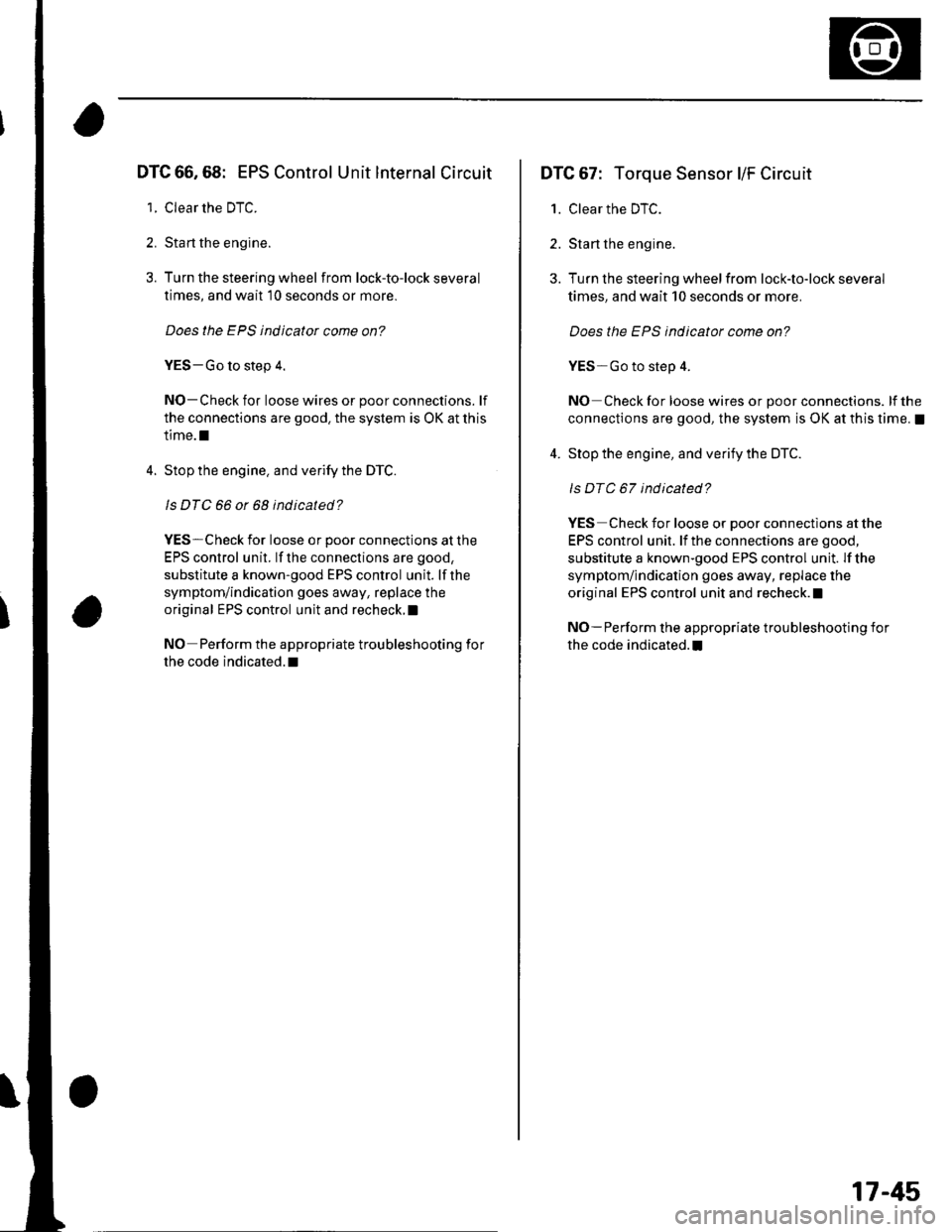
DTC 66,68: EPS Control Unit lnternal Circuit
1. Clear the DTC.
2. Sta rt the engine.
3. Turn the steering wheel from lock-to-lock several
times, and wait 10 seconds or more.
Does the EPS indicator come on?
YES-Go to step 4.
NO-Check for loose wires or poor connections. lf
the connections are good. the system is OK at this
time.l
4. Stop the engine. and verify the DTC.
ls DTC 66 or 68 indicated?
YES-Check for loose or poor connections at the
EPS control unit. lf the conneclions are good,
substitute a known-good EPS control unit. lf the
symptom/indication goes away, replace the
original EPS control unit and recheck.I
NO Perform the appropriate troubleshooting for
the code indicated. t
DTC 67: Torque Sensor l/F Circuit
1. Clear the DTC.
2. Start the engine.
3. Turn the steering wheelfrom lock-to-lock several
times, and wait 10 seconds or more.
Does the EPS indicator come on?
YES-Go to step 4.
NO Check for loose wires or poor connections. lf the
connections are good, the system is OK at this time. !
4. Stop the engine, and verify the DTC.
ls DTC 67 indicated?
YES Check for loose or poor connections at the
EPS control unit. lf the connections are good,
substitute a known-good EPS control unit. lf the
symptom/indication goes away, replace the
original EPS control unit and recheck. !
NO-Perform the appropriate troubleshooting for
the code indicated.I
17-45
Page 537 of 1139
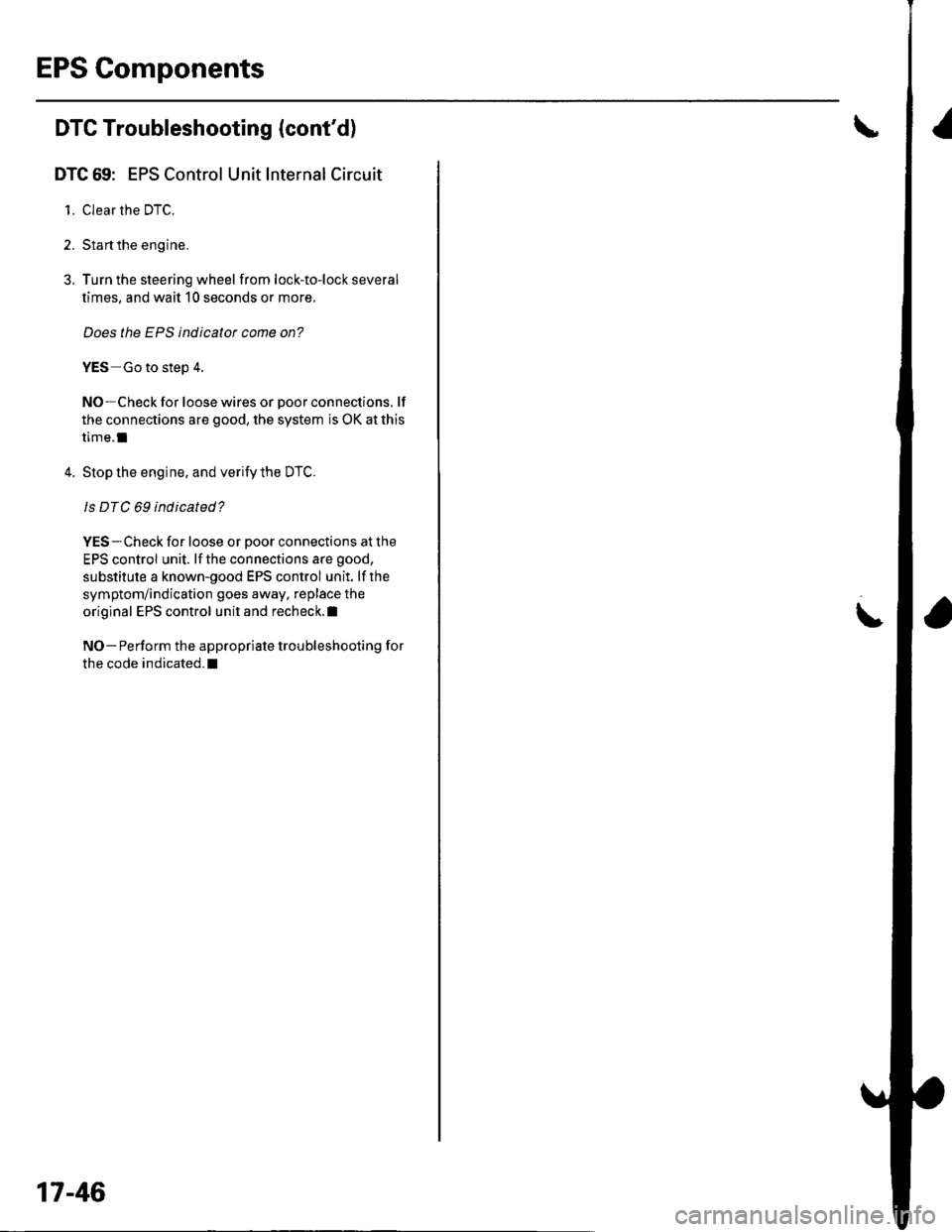
EPS Components
DTC Troubleshooting (cont'd)
DTC 69: EPS Control Unit Internal Circuit
1. Clear the DTC.
2. Start the engine.
3. Turn the steering wheel from lock-to-lock several
times, and wait 10 seconds or more,
Does the EPS indicator come on?
YES Go to step 4.
NO-Check for loose wires or poor connections. lf
the connections are good, the system is OK at this
time.l
4. Stop the engine, and verify the DTC.
ls DTC 69 indicated?
YES-Check for loose or poor connections at the
EPS control unit. lf the connections are good,
substitute a known-good EPS control unit. lf the
symptom/indication goes away, replace the
original EPS control unit and recheck.l
NO- Perform the appropriate troubleshooting for
the code indicated.l
17-46
Page 613 of 1139

Gonventional Brake Components
IBrake Booster Test
Functional Test
1. With the engine stopped, press the brake pedal
several times to deplete the vacuum reservoir, thenpress the pedal hard, and hold itfor 15 seconds. lfthe pedal sinks, either the master cylinder is
bypassing internally, or the brake system (master
cylinder, lines. modulator, or calipers) is leaking.
2. Start the engine with the brake pedal pressed. lf thepedal sinks slightly, the vacuum booster is workingproperly. lf the pedal height does not vary, thebooster or check valve is faulty.
3. With the engine running, press the brake pedal
lightly. lfthe brake pedal sinks more than 1O mm
{3/8 in, ) in 3 minutes, the master cylinder is faulty.A slight change in pedal height when the Ay'C
compressor cycles on and off is normal. (The A,/C
compressor load changes the vacuum available tothe booster.)
Leak Test
1. Press the brake pedal with the engine running, thenstop the engine. lf the pedal height does not vary
while pressed for 30 seconds, the vacuum boosteris OK. lf the pedal rises, the booster is faulty.
2. With the engine stopped, press the brake pedal
several times using normal pressure. When thepedal is first pressed, it should oe row.
On consecutive applications, the pedal height
should gradually rise. lfthe pedal position does notvarv, check the booster check valve.
19-18
3. Disconnect the brake booster vacuum hose (check
valve built-in) (A) at the booster side.
5.
4.Start the engine, and let it idle. There should bevacuum available. lf no vacuum is available, thecheck valve is not working properly. Repiace thebrake booster vacuum hose and check valve, andrelesI.
Reconnect the brake booster vacuum nose.
Start the engine, and then pinch the brake boostervacuum hose between the check valve and thebooster,
Turn the ignition switch OFF, and wait 30 seconds,Press the brake pedal several times using normalpressu re,
When the pedal is first pressed, it should be low.On consecutive applications, the pedal height
should gradually rise.
. lf the pedal position does notvary, replacethe
brake booster.. lf the pedal position varies, replace the brake
booster vacuum hose/check valve assembly.
Page 625 of 1139
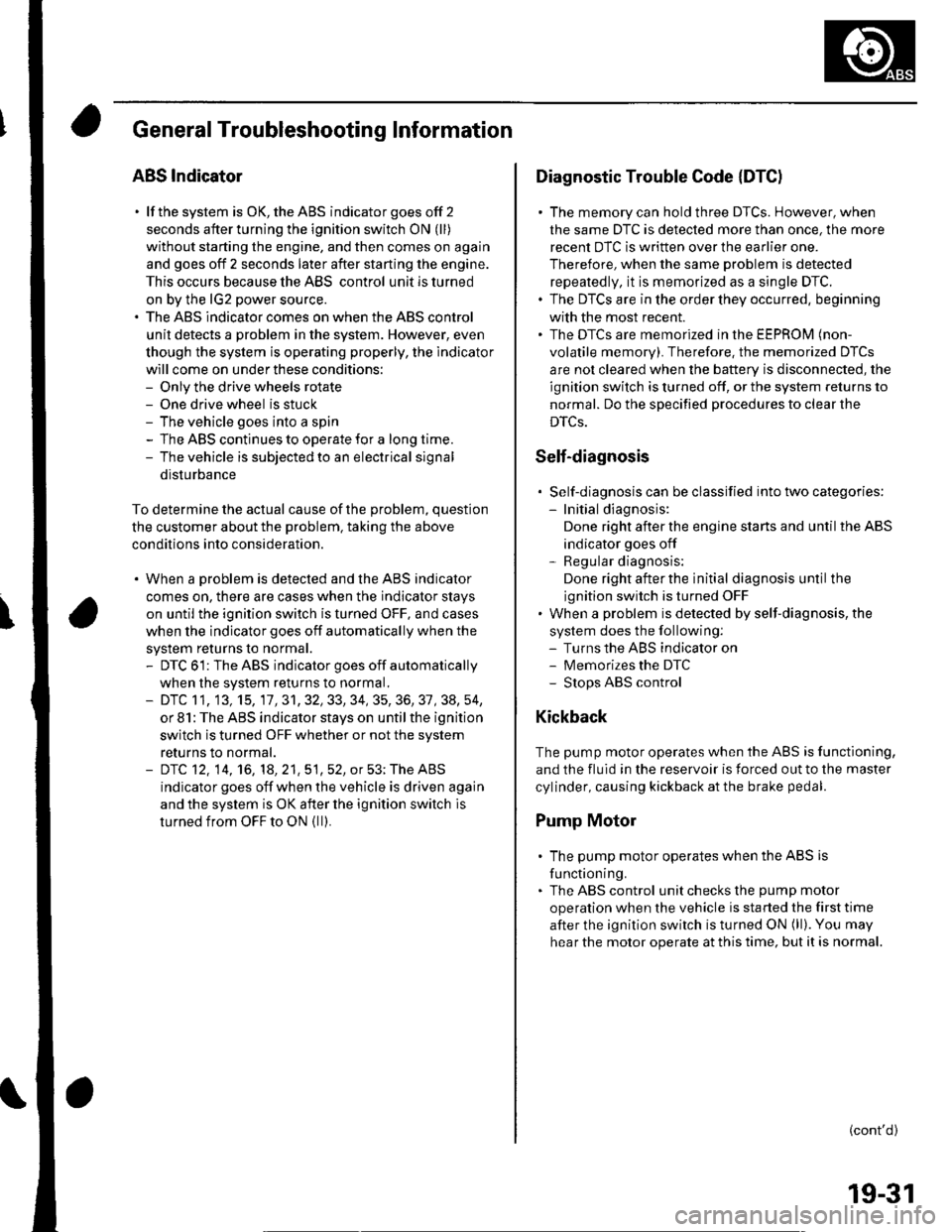
General Troubleshooting Information
ABS Indicator
. lf the system is OK,theABS indicator goes off 2
seconds after turning the ignition switch ON (ll)
without starting the engine, and then comes on again
and goes off 2 seconds later after starting the engine.
This occurs because the ABS control unitisturned
on by the lG2 power source.. The ABS indicator comes on when the ABS control
unit detects a problem in the system. However, even
though the system is operating properly, the indicator
will come on under these conditions:- Only the drive wheels rotate- One drive wheel is stuck- The vehicle goes into a spin- The ABS continues to operate for a long time.- The vehicle is subjected to an electrical signal
disturbance
To determine the actual cause of the problem, question
the customer about the problem. taking the above
condilions into consideration.
. When a Droblem is detected and lhe ABS indicator
comes on, there are cases when the indicator stays
on until the ignition switch is turned OFF, and cases
when the indicator goes off automatically when the
sYstem returns to normal.- DTC 61: The ABS indicator goes off automatically
when the system returns to normal.- DTC 11, 13,15,17 ,31,32,33, 34, 35, 36, 37, 38, 54,
or 81: The ABS indicator stays on until the ignition
switch is turned OFF whether or not the system
returns to normal.- DfC 12, 14, 16, 1a,21,51,52, or 53; The ABS
indicator goes off when the vehicle is driven again
and the system is OK after the ignition switch is
turned from OFF to ON {ll}.
Diagnostic Trouble Code {DTCI
. The memory can hold three DTCS. However, when
the same DTC is detected more than once, the more
recent DTC is written over the earlier one.
Therefore, when the same problem is detected
repeatedly, it is memorized as a single DTC.. The DTCs are in the order they occurred, beginning
with the most recent.. The DTCS are memorized in the EEPROM (non-
volatile memory). Therefore. the memorized DTCs
are not cleared when the battery is disconnected, the
ignition switch is turned off, or the system returns to
normal. Do the specified procedures to clear the
DTCs.
Self-diagnosis
. Self-diagnosis can be classified into two categories:- Initial diagnosis:
Done right after the engine starts and until the ABS
indicator goes off- Regular diagnosis:
Done rightafterthe initial diagnosis until the
ignition switch is turned OFF. When a problem is detected by self-diagnosis, the
system does the following:- Turns the ABS indicator on- Memorizes the DTC- Stops ABS control
Kickback
The pump motor operates when the ABS is functioning,
and the fluid in the reservoir is forced out to the master
cylinder, causing kickback at the brake pedal.
Pump Motor
. The pump motor operates when the ABS is
functioning.. The ABS control unit checks the pump motor
operation when the vehicle is started the first time
after the ignition switch is turned ON (ll). You may
hear the motor operate at this time, but it is normal.
(cont'd)
19-31
Page 634 of 1139
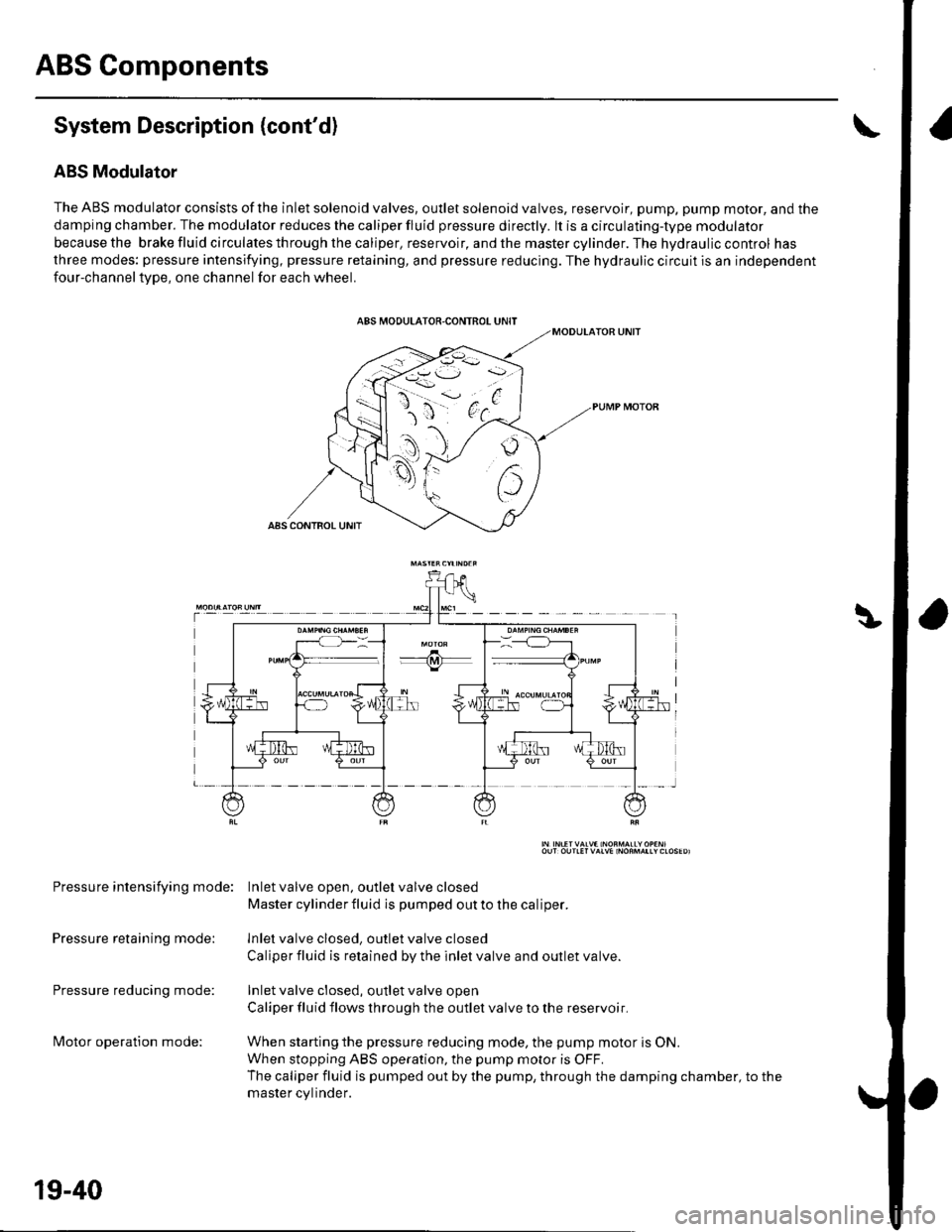
ABS Components
System Description (cont'd)
ABS Modulator
The ABS modulator consists of the inlet solenoid valves, outlet solenoid valves, reservoir, pump, pump motor, and the
damping chamber. The modulator reduces the caliper fluid pressure directly. lt is a circulating-type modulator
becausethe brakefluidcirculatesthroughthecaliper,reservoir,andthemastercylinder.Thehydrauliccontrol has
three modes: pressure intensifying, pressure retaining, and pressure reducing. The hydraulic circuit is an independent
four-channeltype, one channel for each wheel.
Pressure intensifying mode: Inletvalve open, outlel valve closed
Master cylinder fluid is pumped out to the caliper.
Pressure retaining mode: lnlet valve closed, outlet valve closed
Caliper fluid is retained by the inlet valve and outlet valve.
Pressure reducing mode: Inlet valve closed, outlet valve open
Caliper fluid flows through the outlet valve to the reservoir.
lvlotor operation mode: When starting the pressure reducing mode, the pump motor is ON.
When stopping ABS operation, the pump motor is OFF.
The caliper fluid is pumped out by the pump, through the damping chamber, to the
master cvlinder.
19-40